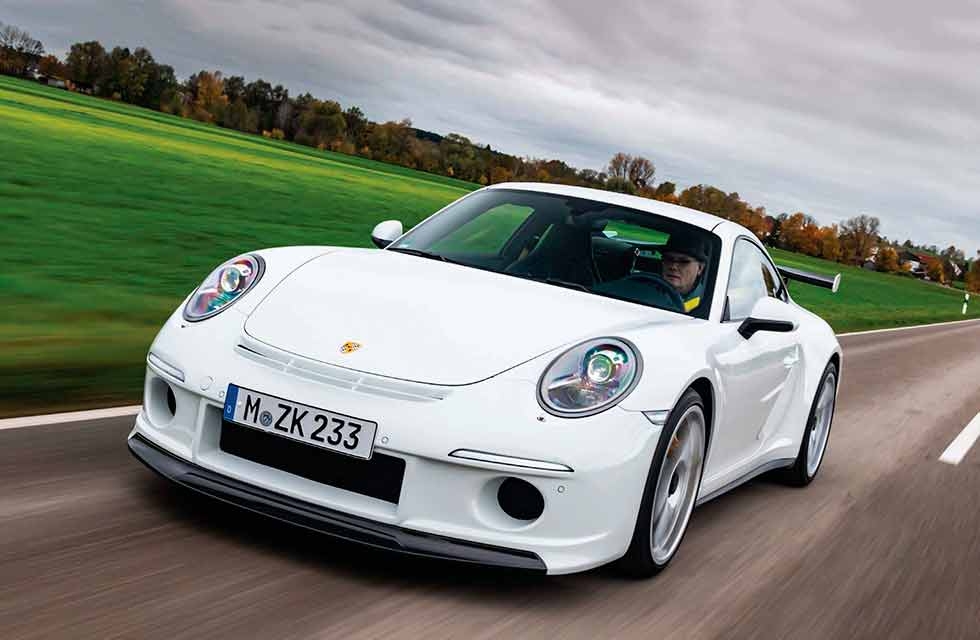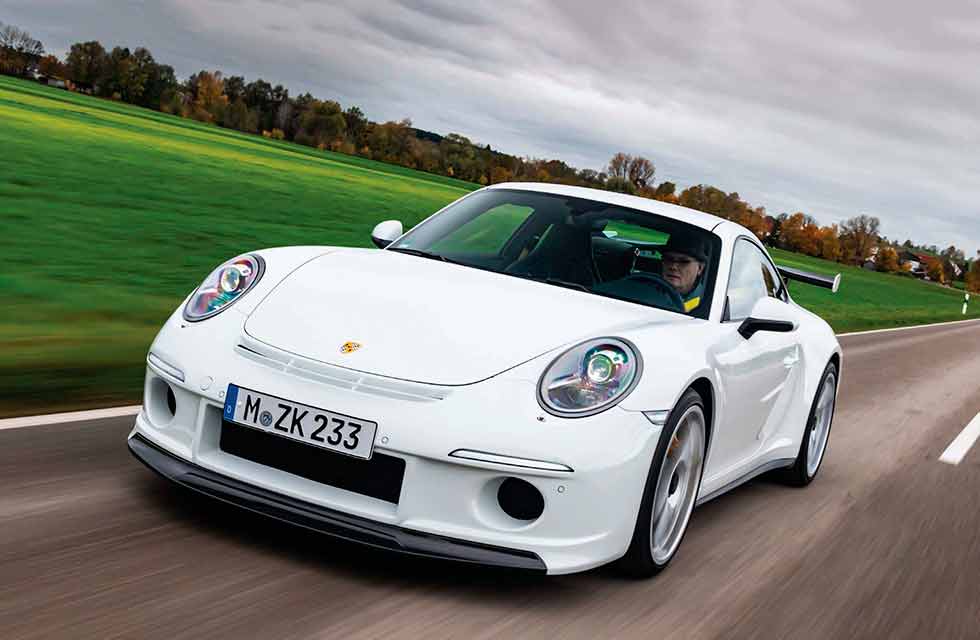
The Grand Tour. Suave and serene, Ruf’s brand new Grand Tourer is among the least extrovert cars to emerge from Pfaffenhausen. Based on the 991 gen 2 GTS, it’s an amazingly competent car that espouses modernity with a sprightly vitality that’s absent in the standard model. Words: Johnny Tipler. Photography: Antony Fraser.
Ruf’s latest 991 based GT and a blast from the past
NEW RUF GT Grand Touring supercar style in Ruf’s latest 991 based road weapon
Ruf Gran Turismo! There’s a certain logic to it and, surprisingly, there’s never been a Ruf bearing the GT designation until now.
Sure, there was a 996 based RGT, but in the complex roster of Ruf suffixes, the latest offering from the Pfaffenhausen stable is, concisely, labelled the GT. Somewhat remarkable that they’ve left it so long to apply those revered – if previously overused – initials, given that all Ruf models are Grand Touring cars in the best traditions of, well, grand touring. Too obvious, perhaps. Some Rufs are slightly more opulent than others, but they’re all fast, luxurious cars that you wouldn’t hesitate to cross continents in, and the Ruf GT very much hits the bullseye in that department. Now, on our annual pilgrimage to south Germany, we take the grand tour.

The Ruf GT is based on the gen 2 991 GTS, and was created for the 2019 Geneva show, so it’s very much this year’s model. ‘It’s based on the twin-turbo Carrera engine,’ says PR Marc-André Pfeifer, ‘but with our upgrades installed. It’s the first step to a Ruf car, one that you can use every day, but one that’s not as hardcore as some Ruf models. It’s still pretty fast, given it has only (!) 515bhp, and it’s got a lot of torque. It has a wide power band because of the turbocharged engine, plus a lightweight stainless exhaust system, and the car itself is very light (1450kg) with the manual gearbox.’
The GT can be configured according to customer preferences, with two- or four-wheel drive, for example, or 7-speed manual or 7-speed PDK transmission. Its 3.0-litre flat-six is based on the GTS’s twin-turbo unit, but power rises from 444bhp to 515bhp at 6500rpm, with torque rated at 476lb ft at 3500rpm, enabling it to do 62mph in 3.4sec, which is slightly quicker – 0.2s – than the fastest 991 GTS with 4WD and PDK transmission. A Ruf build means anything is possible. However, this particular car’s owner opted to retain the standard suspension, though of course it does have the Ruf engine and braking upgrades. Ballpark price of the GT is round about €350,000.
The Geneva car was black with black wheels, while this one is white, sporting Ruf’s own five-spoke 20in wheels, shod with Michelin Pilot Sport Cup tyres, 255/30 ZR 20 front and 325/25 ZR20 rear. The frontal treatment is typical Ruf, with a GT2- style grille topping the sweep of the front panel, a pair of circular vents in the lower quarters of the valance, with carbon-fibre lower lip and splitter. Prominent on the lid is the striking new Ruf shield badge, based on the Pfaffenhausen coat of arms. The GT is also fitted with Ruf’s door mirrors, and finished with a ducktail engine lid – which reminds me of a similar one that Alois gave me for my own 996 a few years back. The difference with that is the GT also sports a cantilevered wing that soars above the ducktail spoiler, the profile of which is subtly contoured. There are prominent air vents in the rear-three-quarters of the rear valance, with two sets of twin tailpipes emerging either side of the slatted carbon diffuser.
It is quietly understated in most respects; there’s no ID on the rear lid, while in the cabin the only giveaway as to its identity are the slim white bands along the doors, across the centre line of the dashboard and around the centre console, and on the back side of the shift gaiter is a little GT badge. It has Alcantara lining the ceiling and the A-, B- and C-pillars, which conceal the integral Ruf roll cage, with drilled aluminium alloy pedals and a left foot-rest monogrammed with Ruf. Yellow belts provide a splash of colour, while the distinctive black-and-white Houndstooth check inserts to the Ruf sports seats offer a classic twist. A discussion ensues as to the correct name for, er, houndstooth tweed: it could be pied-depoule, apparently, meaning hen’s foot. Personally, I’ll stick with the doggy analogy. Meanwhile, in the cosy rotunda at Ruf’s Pfaffenhausen HQ, we’re chatting with Marcel Groos (Alois’s son) and press officer Marc-André Pfeifer. Verena Proebst is here, too, and as curator of nearby Automuseum Adlkofen, and whose dad Walter raced Porsche 910 #001 and a 908 Spyder back in the day, she’s keeping a weather eye on the classic elements of our tale.
Depending on the spec required, the Ruf GT is one of the firm’s less radical models and therefore not as labour intensive to produce as cars such as the CTR or SCR. But, as Marcel points out, ‘in fact, there’s generally a waiting list for all the cars, because we are mainly concentrating on production of the new CTR4, but the back order for modern cars is not too long.’ The CTR4 production facility is based on another site behind Ruf’s busy PC (people regularly drive the 60-miles from Munich to have work done) and servicing and restoration building on the opposite side of the flower-bedecked roundabout that coincidentally forms a hub for the company’s increasingly multifaceted operations. Pfaffenhausen’s peripheral light industrial conurbation has grown considerably since we first started coming here, maybe 15 years ago, and it was Ruf’s expansion that started the ball rolling. But the new CTR facility can only come on stream when the model is finally signed off: the yellow pre-production model we drove last year remains the single CTR4 completed – while the blue version currently gracing the showroom is complete though currently for display only. Meanwhile, Alois the perfectionist is susceptible to a constant stream of ideas and tweaks suggested by associated designers and engineers. So, they can’t commit to starting production until all possibilities for further modifications are exhausted.
The discussion moves on to the extent of the Ruf operation; on our visit it’s clear that the buildings opposite the showroom and service block are undergoing modification. There’s another facility adjacent to one of Ruf’s hydroelectric power stations in a neighbouring village which serves as a prototype assembly shop, though generally Ruf’s carbon-fibre body panels are manufactured by an outside source. ‘We don’t do that in-house because for the moment it’s not logical to get into fabrication at that level with all the specialised equipment and environments we would need. We need to be sure of the continuity, because once we’ve started production we don’t want to compromise our targets and schedules.’ Marcel indicates another development on the opposite side of the ubiquitous Pfaffenhausen roundabout: ‘there is a possibility that we could house the whole restoration department there, and that would create more space in the service centre, though equally it could be for the CTR production; so, for now, we wait.’
Clearly, they’re in the throes of some fairly radical departmental rationalisation. ‘We also have to take care of our workforce; we have to decide how many technicians we will need to build the CTR4 over the next two years, and they will need space to park their own cars, and a bigger place for them to have lunch; so these are now the things we need to nail down, because otherwise you end up building something new every year and we don’t want to be doing that.’ At this point my colleague is rendered helpless by the spectacle of salad-filled Pretzels presented for our lunch: there’s no logic…
Enough talking: next, we head out into the familiar Swabian country roads where we can rely on minimal traffic and stretches of smooth blacktop for the action photos. As you would expect with a modern Ruf, the power delivery is spontaneous and colossal, the revs soar well into the high numbers, 6- and 7000rpm, though I can also cruise nonchalantly at 3000 rpm in 6th, and I’m also noticing a bit of 7th on the longer transit sections. The curves are calling. As I set it up for the nicely open Sbends, I don’t think I’ve driven anything quite so fast through here; it really is delivering towering performance, smooth and perfectly controllable, the steering so precise and light, and all the while it’s got this huge head of steam available. And then when I brake and downshift through the gears to turn around at virtually no kph, it’s entirely compliant.
Irresponsible or not, you have to see just how quickly you can go in a car like this (provided there’s no other traffic in sight). On the straight stretch between turnarounds, let’s say a quarter of a mile, I very nearly nudge 250kph, and in other less frenetic runs I achieve 7th gear, too, while the relatively big drop in revs between 6th and 7th declares this to be a cruising ratio. The regular reader will be aware that in order to provide the snapper with ample opportunities to get the money shot the driver is obliged to make several passes in front of the camera, requiring a safe turnaround at either end of the passage. Doing this once or twice tends not to attract too much attention. But do it ten or 12 times, and people start to take notice.
And so it was; I became aware that an ancient hatchback had shuffled down an adjacent lane beside ‘my road’, and a middleaged woman had got out to watch. Cornering shots in the bag, we were about to do the panning routine when Rafael, our Ruf rep, took a call from base, saying that our activities had been relayed to the local police. Happily, Marcel fielded the call and defused the situation. We did change location, though.
Summing up, the Ruf GT is best of both worlds: it’s the daily driving supercar, and it’s also the peerless Grand Touring car; one you drop your kids off at school in, and, come the hols, you head for the beauty spots. It looks the part, too. It’s absolutely secure at very high speeds, yet docile in an urban environment or when pootling is required. All Ruf cars are like that to a certain extent. But the GT is rather different. It’s a canny augmentation of a perfectly competent stock machine that contrives to exceed the standard model’s parameters without proclaiming its prowess too overtly. Leave that to the driver.
MARKET FORCES
Inevitably, the current classic car market comes in for scrutiny. ‘We recognise that the classic car market in Europe is flattening off, though it is still high in the USA,’ says Alois Ruf’s son Marcel Groos. ‘I can’t wait to see what happens when the Asian market opens up, with an import allowance for old timers. That means potentially 3 billion people entering the market, which will double the number of customers who are currently interested. But, at the moment, many people are buying these cars just to re-sell, to make a fast Euro, as we say, and it worked for two years if you had a very special car, but now everybody thinks that his car is special because it’s got red stitching or whatever, and they try to sell you everything as special editions. My next headache could be that I want a GT3 or whatever as my road car, but then Porsche will limit production and I shan’t be able to afford it. And the ones they do release will never be driven, so that, after three years, you’ll see 60 different cars advertised with between 0- and 2000km, because no-one is driving them. And in the first place you probably need to already have a Boxster Spyder or a GT4, otherwise you’re not allowed to buy the RS. They are made to be driven, even more than regular cars, but the way we orientate the marketing, the way we sell the cars, turns everything upside down.’ He warms to the theme: ‘Then you go to a Porsche meeting or trackday, and you’ll see 50 GT2 RSs, and 20 of them have less than 2000km because they came on a trailer; what’s wrong with people? Why are they buying this car? Most of the people who would love to have the car to drive it, they are completely out of the market. I’m sure Porsche are doing the best thing for themselves in monetary terms, but you can’t help but wonder if they said, yes there’s an RS version of this model, but we’re not going to restrict the numbers; if you want to order an RS, just order one, and then there won’t be any after-market hiking of the price, and they’d also probably sell more cars.’
Above and below: Distinctive Ruf five spoke wheels are something of a design classic. Polished pipes add some bling to the monochrome look.
Every manufacturer/tuner must have a first rung of the ladder and for Ruf it’s currently the 991 based Ruf GT Some white detailing lifts the largely black interior. Seats have Ruf’s houndstooth Inserts.
Ruf GT is 991 GTS based. Rear features traditional Ruf ducktail rear lid and an attention grabbing, cantilevered wing Not that you can see it, but engine has had a modest power increase (by Ruf standards) from 444bhp to 515bhp. Below: Subtle GT Badging.
CONTACT RUF
Automobile GmbH Mindelheimer Straße 21 D-87772 Pfaffenhausen Tel.: +49 82 65 911 911 [email protected] ruf-automobile.de Thanks to Eurotunnel for facilitating our subterranean passage via Le Shuttle to Le Continent






